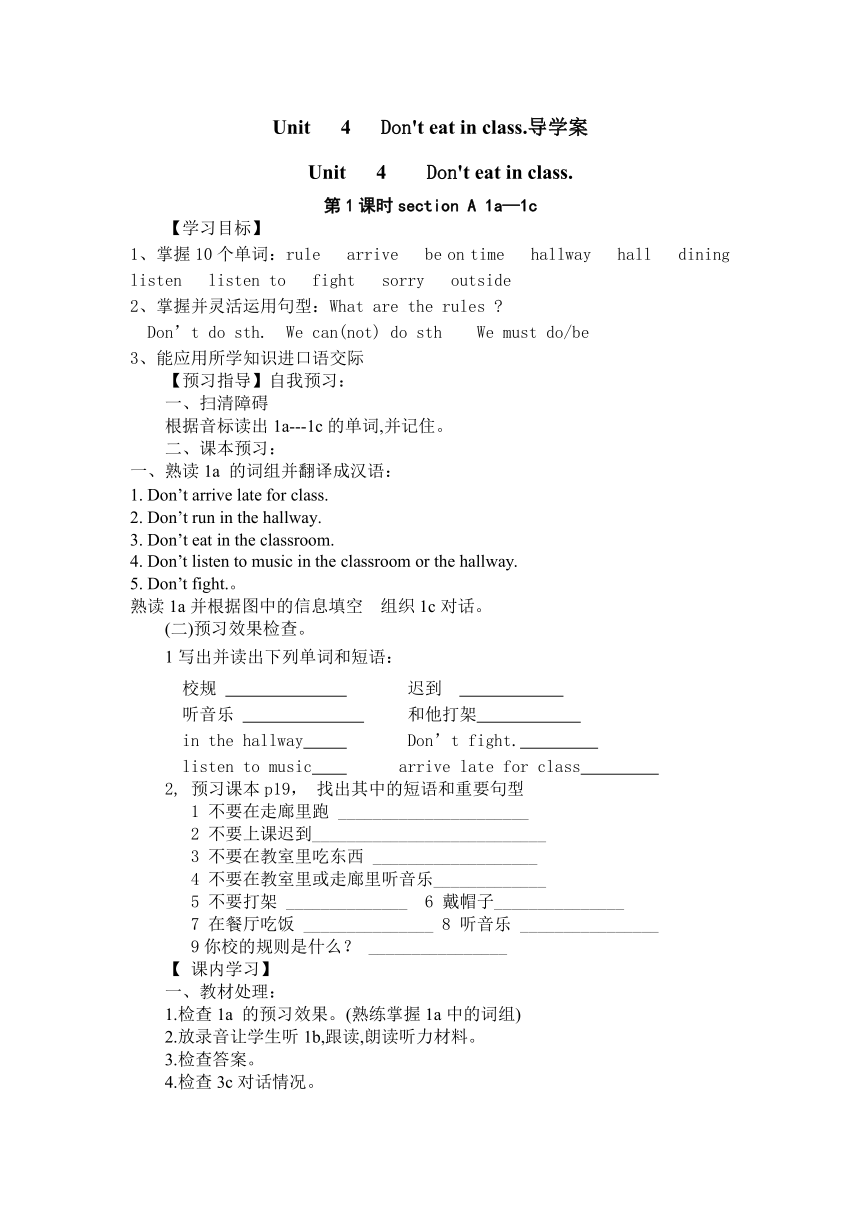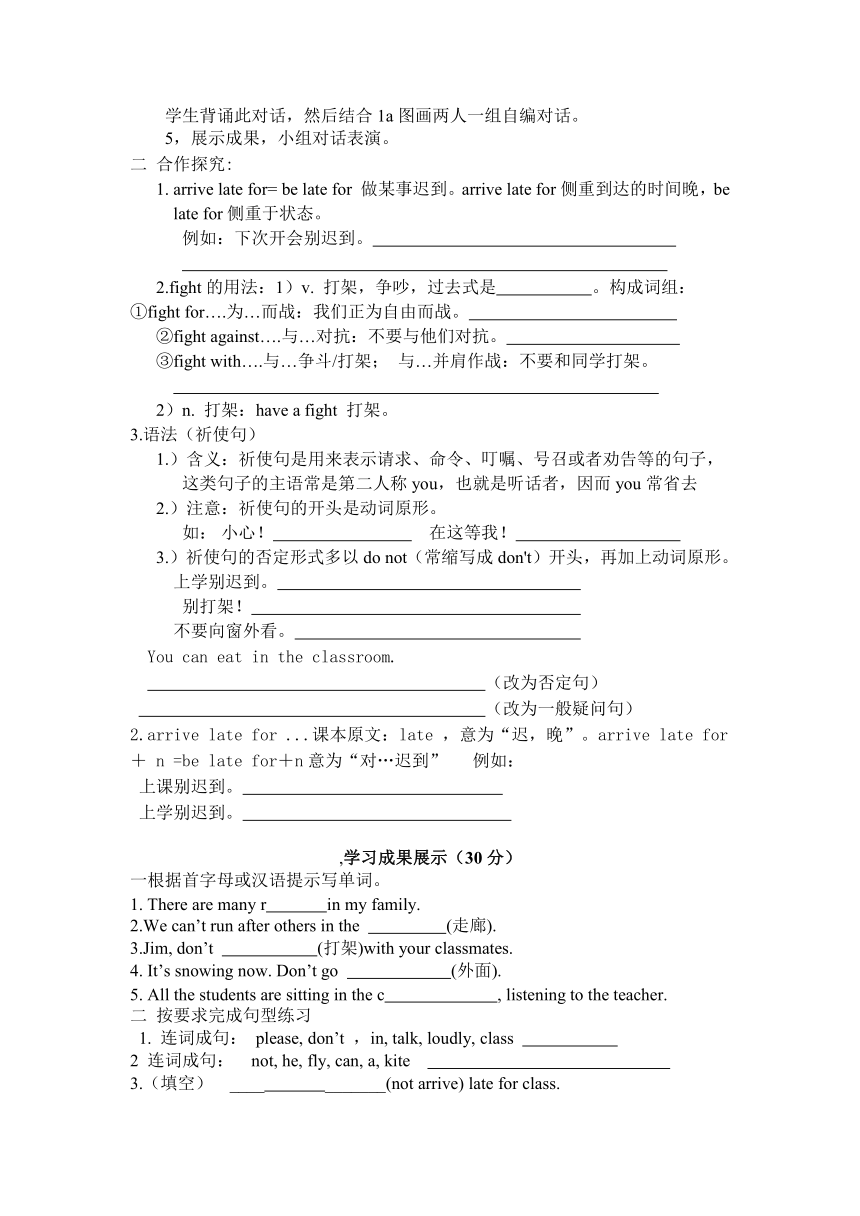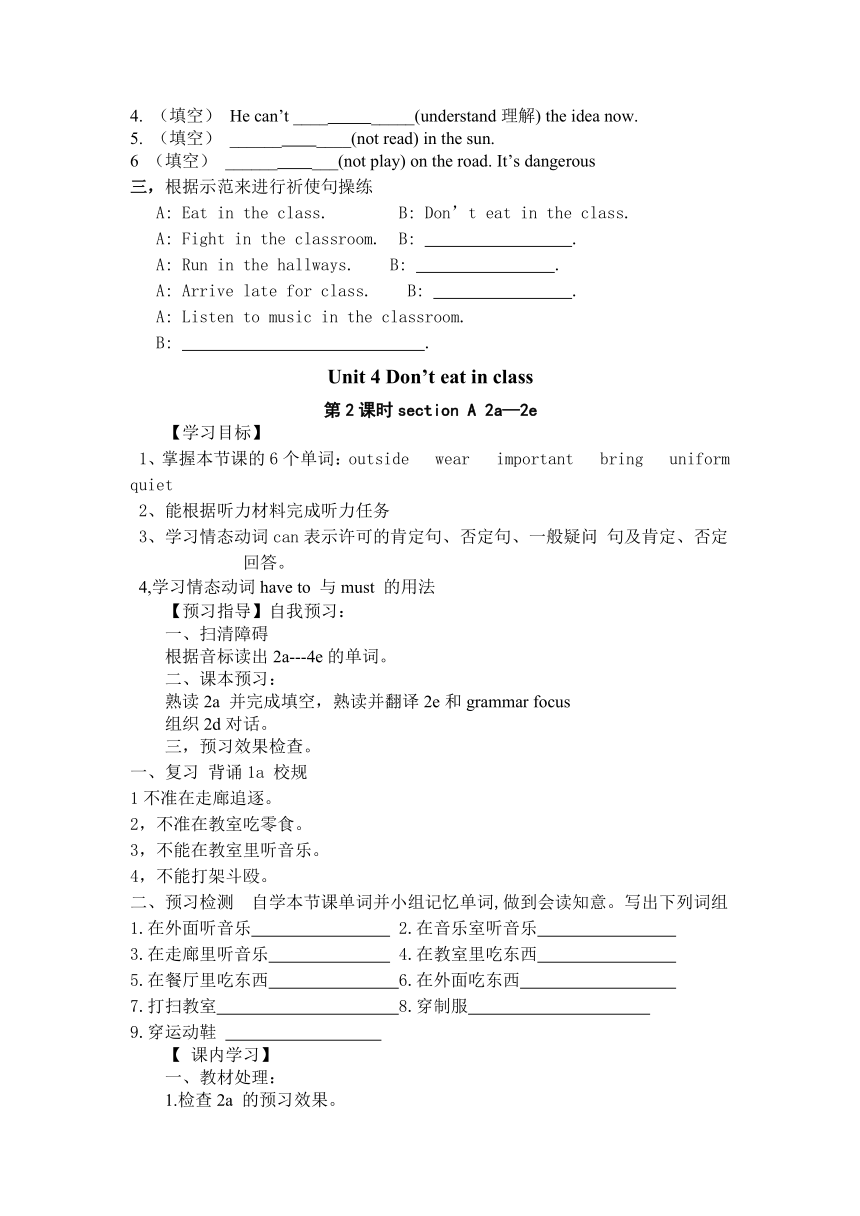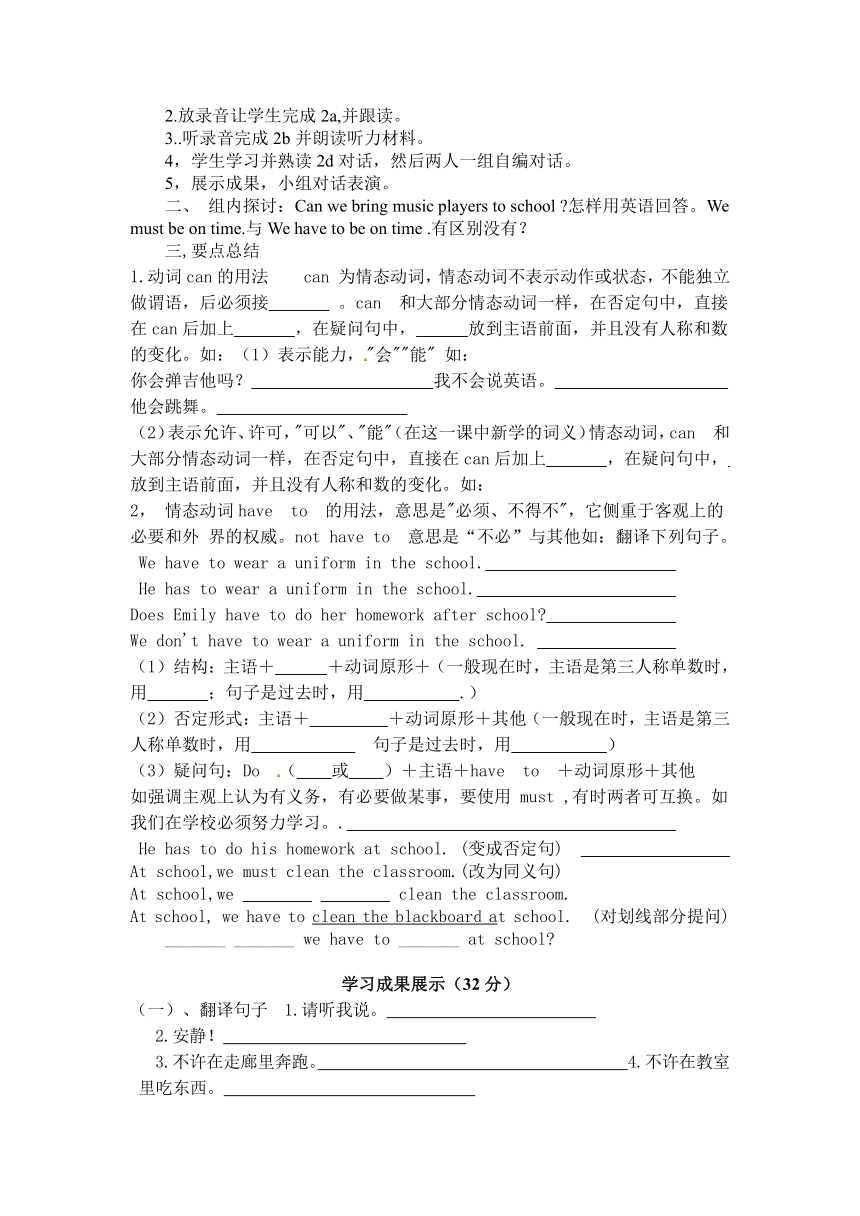Unit 4 Don’t eat in class.单元导学案(5课时)
文档属性
| 名称 | Unit 4 Don’t eat in class.单元导学案(5课时) |  | |
| 格式 | zip | ||
| 文件大小 | 33.1KB | ||
| 资源类型 | 教案 | ||
| 版本资源 | 人教新目标(Go for it)版 | ||
| 科目 | 英语 | ||
| 更新时间 | 2014-03-19 16:01:59 | ||
图片预览





文档简介
Unit 4 Don't eat in class.导学案
Unit 4 Don't eat in class.
第1课时section A 1a—1c
【学习目标】
掌握10个单词:rule arrive be on time hallway hall dining listen listen to fight sorry outside
2、掌握并灵活运用句型:What are the rules
Don’t do sth. We can(not) do sth We must do/be
3、能应用所学知识进口语交际
【预习指导】自我预习:
一、扫清障碍
根据音标读出1a---1c的单词,并记住。
二、课本预习:
熟读1a 的词组并翻译成汉语:
1. Don’t arrive late for class.
2. Don’t run in the hallway.
3. Don’t eat in the classroom.
4. Don’t listen to music in the classroom or the hallway.
5. Don’t fight.。
熟读1a并根据图中的信息填空 组织1c对话。
(二)预习效果检查。
1写出并读出下列单词和短语:
校规 迟到
听音乐 和他打架
in the hallway Don’t fight.
listen to music arrive late for class
2, 预习课本p19, 找出其中的短语和重要句型
1 不要在走廊里跑 ______________________
2 不要上课迟到___________________________
3 不要在教室里吃东西 ___________________
4 不要在教室里或走廊里听音乐_____________
5 不要打架 ______________ 6 戴帽子_______________
7 在餐厅吃饭 _______________ 8 听音乐 ________________
9你校的规则是什么? ________________
【 课内学习】
一、教材处理:
1.检查1a 的预习效果。(熟练掌握1a中的词组)
2.放录音让学生听1b,跟读,朗读听力材料。
3.检查答案。
4.检查3c对话情况。
学生背诵此对话,然后结合1a图画两人一组自编对话。
5,展示成果,小组对话表演。
二 合作探究:
1. arrive late for= be late for 做某事迟到。arrive late for侧重到达的时间晚,be late for侧重于状态。
例如:下次开会别迟到。
2.fight的用法:1)v. 打架,争吵,过去式是 。构成词组:
①fight for….为…而战:我们正为自由而战。
②fight against….与…对抗:不要与他们对抗。
③fight with….与…争斗/打架; 与…并肩作战:不要和同学打架。
2)n. 打架:have a fight 打架。
3.语法(祈使句)
1.)含义:祈使句是用来表示请求、命令、叮嘱、号召或者劝告等的句子,这类句子的主语常是第二人称you,也就是听话者,因而you常省去
2.)注意:祈使句的开头是动词原形。
如: 小心! 在这等我!
3.)祈使句的否定形式多以do not(常缩写成don't)开头,再加上动词原形。上学别迟到。
别打架!
不要向窗外看。
You can eat in the classroom.
(改为否定句)
(改为一般疑问句)
arrive late for ...课本原文:late ,意为“迟,晚”。arrive late for+ n =be late for+n意为“对…迟到” 例如:
上课别迟到。
上学别迟到。
,学习成果展示(30分)
一根据首字母或汉语提示写单词。
1. There are many r in my family.
2.We can’t run after others in the (走廊).
3.Jim, don’t (打架)with your classmates.
4. It’s snowing now. Don’t go (外面).
5. All the students are sitting in the c , listening to the teacher.
二 按要求完成句型练习
1. 连词成句: please, don’t ,in, talk, loudly, class
2 连词成句: not, he, fly, can, a, kite
3.(填空) ____ _______(not arrive) late for class.
4. (填空) He can’t ____ _____(understand理解) the idea now.
5. (填空) ______ ____(not read) in the sun.
6 (填空) ______ ___(not play) on the road. It’s dangerous
三,根据示范来进行祈使句操练
A: Eat in the class. B: Don’t eat in the class.
A: Fight in the classroom. B: .
A: Run in the hallways. B: .
A: Arrive late for class. B: .
A: Listen to music in the classroom.
B: .
Unit 4 Don’t eat in class
第2课时section A 2a—2e
【学习目标】
1、掌握本节课的6个单词:outside wear important bring uniform quiet
2、能根据听力材料完成听力任务
3、学习情态动词can表示许可的肯定句、否定句、一般疑问 句及肯定、否定回答。
4,学习情态动词have to 与must 的用法
【预习指导】自我预习:
一、扫清障碍
根据音标读出2a---4e的单词。
二、课本预习:
熟读2a 并完成填空,熟读并翻译2e和grammar focus
组织2d对话。
三,预习效果检查。
复习 背诵1a 校规
1不准在走廊追逐。
2,不准在教室吃零食。
3,不能在教室里听音乐。
4,不能打架斗殴。
二、预习检测 自学本节课单词并小组记忆单词,做到会读知意。写出下列词组
1.在外面听音乐 2.在音乐室听音乐
3.在走廊里听音乐 4.在教室里吃东西
5.在餐厅里吃东西 6.在外面吃东西
7.打扫教室 8.穿制服
9.穿运动鞋
【 课内学习】
一、教材处理:
1.检查2a 的预习效果。
2.放录音让学生完成2a,并跟读。
3..听录音完成2b并朗读听力材料。
4,学生学习并熟读2d对话,然后两人一组自编对话。
5,展示成果,小组对话表演。
二、 组内探讨:Can we bring music players to school 怎样用英语回答。We must be on time.与We have to be on time .有区别没有?
三,要点总结
1.动词can的用法 can 为情态动词,情态动词不表示动作或状态,不能独立做谓语,后必须接 。can 和大部分情态动词一样,在否定句中,直接在can后加上 ,在疑问句中, 放到主语前面,并且没有人称和数的变化。如:(1)表示能力,"会""能" 如:
你会弹吉他吗? 我不会说英语。 他会跳舞。
(2)表示允许、许可,"可以"、"能"(在这一课中新学的词义)情态动词,can 和大部分情态动词一样,在否定句中,直接在can后加上 ,在疑问句中, 放到主语前面,并且没有人称和数的变化。如:
2, 情态动词have to 的用法,意思是"必须、不得不",它侧重于客观上的必要和外 界的权威。not have to 意思是“不必”与其他如:翻译下列句子。
We have to wear a uniform in the school.
He has to wear a uniform in the school.
Does Emily have to do her homework after school
We don't have to wear a uniform in the school.
结构:主语+ +动词原形+(一般现在时,主语是第三人称单数时,用 ;句子是过去时,用 .)
否定形式:主语+ +动词原形+其他(一般现在时,主语是第三人称单数时,用 句子是过去时,用 )
(3)疑问句:Do ( 或 )+主语+have to +动词原形+其他
如强调主观上认为有义务,有必要做某事,要使用 must ,有时两者可互换。如
我们在学校必须努力学习。.
He has to do his homework at school. (变成否定句)
At school,we must clean the classroom.(改为同义句)
At school,we clean the classroom.
At school, we have to clean the blackboard at school. (对划线部分提问)
_______ _______ we have to _______ at school
学习成果展示(32分)
(一)、翻译句子 1.请听我说。
2.安静!
3.不许在走廊里奔跑。 4.不许在教室里吃东西。
(二).单项填空
1,The students have to wear _______ uniform.
A. a B. an C. the D. /
2,What rules _______ you have to obey (服从)
A. are B. is C. do D. does
3, We _______ eat in the classroom, because it’s impolite (不礼貌) to the teachers.
A. can B. can’t C. must D. need
4,If you arrive late _______ school, you must say _______ to your teacher.
A. for; thanks B. for; sorry C. to; sorry D. in; thanks
5, — Can we hang out(闲逛) in the evening
— _______.
A. Yes, they can B. Yes, we can’t
C. No, you can’t D. No, we can
6, Her bike is broken(坏了). She _______ walk to school.
A. have to B. has to C. has D. Is
7,My mother said to me, “Tom, _______ in bed.”
A. not read B. doesn’t read C. don’t read D. not reading
8, Don’t listen _______ music in the classrooms _______ the hallways.
A. /; And B. /; and C. or; and D. to; or
(三)翻译句子
1. 上体育课我们必须穿运动鞋。
2. 我们可以在餐厅吃东西,但是不可以在教室里吃。
3. 他必需穿校服。
4. 我们可以在外面听音乐吗_______________________________________
Unit 4 Don’t eat in class
第3课时section A 3a—3c
Section B 1a---1d
【学习目标】
掌握本节课的6个单词: out go out practice dish
do the dishes before
2.熟练运用must , have to 以及它们的句式变化。
掌握句型:We must be on time .
We have to be quiet .
Do you have to get to school before 7:20
Does he have to wear a uniform at school
【预习指导】自我预习:
一、扫清障碍
根据音标读出本节课-的单词。
二、课本预习:
熟读Grammar focus, 复习本单元的重要句型.
学习3a 并完成练习,谈校规
运用本单元句型完成3b
三,预习效果检查。完成句子
1.你们学校有什么规定? What are the your school
2.请勿在走廊上追逐也不要上课迟到。
Don’t run and don’t late for class.
3.我们可以在学校吃东西吗? Can we in school
4.我们可以在食堂吃东西但不可以在课室吃。
We can eat in the _____, but we can't eat .
5.你们必须在学校穿制服吗? 是的,我们要穿。
Do you wear a uniform at school Yes, ______ _______.
6.我们还有什么必须得做吗?你们必须打扫课室。
What do we have to do You have to
【 课内学习】
一、教材处理:
1.检查预习效果
学生口译听到的句子(Grammar focus)
2.完成3abc的练习,
展示成果,小组对话表演。
4.听力练习,完成Section B 1abcd,
二、 组内探讨:要点总结
Do you have to wear a uniform at school ?
1.have to 为固定短语,意为“不得不”,强调由客观原因造成不得不去做某事,有各种时态和人称变化,在变否定句和疑问句时借助动词do, does, did。
Eg: 你不必天天来。
-你在学校是不得不穿校服吗? -是的,我们是。 不,我们不是。
- -
2.注:must也意为“必须,应该,不得不”,强调由于主观原因一定要做某事,只用于一般现在时,没有时态和人称的变化,在否定句中或作否定回答时用needn’t。
Eg:你必须先在就完成家庭作业。
-我现在必须回家吗?-是的,你必须回家。/不,你不必。
- -
学习成果展示(30分)
一,按要求改写句子。
1. I can sing this song in English. (变成否定句)
2. Eat food in the classroom. (变成否定句)
3. He has to do his homework at school. (变成否定句)
4. You can watch TV after supper. (变成祈使句)
5. They can play basketball after school. (变成一般疑问句)
6. Mr King has to stay at home. (对划线部分提问)
二,单选:
1.-Why are you walking so fast Because I get home to do my work.
A. have B. go to C. have to D. has to
2. You go in a hurry(匆忙).There’s enough time left.
A. have to B. hadn’t C. don’t have to D. mustn’t
3,Sorry, I can’t it in English. I can only Chinese.
A. speak, talk B. say, tell C. say, speak D. talk, say
4.-Can you cook dinner . ..It’s easy.
A. No, I can’t B. Yes, I can C. No, I can D. Yes, I need
三,用方框中的此完成对话,每空一词
do, watch, into, have, can’t, like , listen, clean, can, don’t
A: Do you your new school
B: Yes. It’s a good school and there are many rules.
A: Really you go out on school nights
B: Yes, we can. But we eat in class. And we can’t arrive late for class.
A: Do you to wear uniforms
B: No, we have to do that. But we have to the classroom every day. We can go the classroom without the teacher. We can _______ to music outside.
A: Can you TV after school
B: No, we .We have to the homework
Unit 4 Don't eat in class.
第4课时Section B (2a-2c)
【学习目标】
掌握本节课的15个单词: make bed dirty kitchen more noisy relax read terrible feel strict be strict (with sb ) remember follow follow the rules luck
2.学习阅读方法,根据问题查找有用信息。
3,掌握句型:There are too many rulers !
After dinner ,I can not relax either .
【预习指导】自我预习:
一、扫清障碍
根据音标读出P15的单词。
二、课本预习:
1,熟读Grammar focus, 复习本单元的重要句型.
2,阅读文章了解其中反映的信息,熟读文章。
三,预习效果检查。
快速阅读3a,找出下列词组:
1.太多的规定 2.不得不 3.早餐后
4.在学校期间的晚上 5.整理床铺
6.做作业 7.在周末
8.看电视 9.上床睡觉
10.制订规则
阅读P23页的2b并回答问题:
1. Why isn’t Molly Brown happy
2. What can’t she do in class
3. When does she have to be in bed 4. What does she have to do before she can watch TV
5.Why can’t Molly play baseball after school
【 课内学习】
一、教材处理:
1.检查预习效果。
A,读熟单词, B,检查预习思考题 C,完成2c练习
组内探讨与要点总结
1. I have too many rules in my house.
1)many一般修饰 ,表示“许多的”,前面加副词too,则表示“太多的”。too many后要跟可数名词复数。
如:她有太多的问题要问。
2)too much意为“太多的”但用来修饰不可数名词。
如:我们有太多的家庭作业要做。
too much意为“太多”,作adj. ,修饰不可数名词也可作副词修饰动词。
much too意为“太,简直”,相当于very, 只作adv. 修饰形容词和副词。
too many 意为“太多”,只作adj. 修饰可数名词复数。
2. I can’t watch TV on school nights.
1)在上学期间的晚上 ,night前若有其他词汇修饰,指具体的某个晚上,应用介词on。如:
在冬天的晚上 在星期天的晚上
2)若泛指在晚上,则用介词at.在夜晚
如:. 他学习到深夜。
凯特正在床上。
学习成果展示(10分)
阅读短文,根据其内容,从短文后所给的A、B、C、D四个选项中,选择最佳答案。
Mike is nine this year. He is in Grade Three. His father drives a car in a factory and his mother works in a hospital(医院).
It’s a Saturday afternoon. Mike is sitting in the room and reading a book. Kate comes up to him and says, “Brother! Mommy wants you to help her.”
“What does she want me to do ” asks the boy. “To wash the apples or to cut(切)the cakes ”
“Neither(都不是),” answers Kate. “She’s watering flowers in the garden. She wants you to carry(搬运) some water for her.”
“Why don’t you do that ”
“Mommy says I’m too young.”
“Don’t you see I’m busy now ”
“What are you doing here, then ”
“I’m reading a book. I can’t go there.”
“Is this an interesting book ”
“Yes, it is.”
“Well, let me help you read the book and you go to help her,” says Kate.
( ) 1. There’re _______ people in Mike’s family.
A. two B. three C. four D. five
( ) 2. Kate is Mike’s _______.
A. elder(更大的) sister B. younger(更小的) sister
C. elder brother D. younger brother
( ) 3. Tom doesn’t go to school because _______.
A. it’s Saturday B. he’s ill
C. he wants to read the book D. he wants to help his mother
( ) 4. Tom doesn’t want to help his mother because _______.
A. he’s very busy B. he has some homework to do
C. he’s very hungry D. he’s very lazy
( ) 5. Kate comes to Mike and wants _______.
A. to read the book B. to carry water
C. to water flowers D. him to help their mother
Unit 4 Don’t eat in class
第5课时Section B (3a-self check)
【学习目标】
1.复习本单元重要词组和句型。
2.学习信件的写法。
3,练习写信件
【预习指导】自我预习:
一,重要词组
rule 规则
obey rules 遵守规则 follow the rules 守规则
break rules 违反规定 don’t fight 不打架
have to 不得不;必须 arrive/be late for. . . 迟到
no talking 不许讲话 listen to 听-------
be strict with /in 对-----严格 be noisy /quiet 吵闹/安静
二,重要语法
A,祈使句的肯定句式分为三种类型,具体说有:
1.Do型,即 ① +其他成分。
2.Be型,即Be+ ② 。
3.Let型,即Let+ ③ + ④ +其他成分。
[总结感悟]①行为动词原形 ②表语 ③宾语 ④动词原形
否定句都加don’t
B, can , have to , must 的用法
【 课内学习】
一、教材处理:
1,复习邮件的写法,复习情态动词的用法,完成3a
2,复习有关校规、家规的说法,完成3bc
3,读本单元重要词组和句型,完成self check
,学习成果展示(20分)
书面表达。
阅读下列规章,然后写一篇短文来介绍Tom’s rules。
Tom’s rules
1. Get up at 6:00.
2. Go to school at 6:15.
3. Don’t eat outside.
4. Don’t listen to music on school days.
5. Don’t watch TV on school nights.
6. Be back home by 12:00 in the morning and by 9:20 in the evening.
______________________________________________________________________________________________________________________________________________________________________________________________________________________________________________________________________________________________________________________________________________________________________________________________________________________________________________________________________________________________________________________________________________________________________________________________________________
Unit 4 Don't eat in class.
第1课时section A 1a—1c
【学习目标】
掌握10个单词:rule arrive be on time hallway hall dining listen listen to fight sorry outside
2、掌握并灵活运用句型:What are the rules
Don’t do sth. We can(not) do sth We must do/be
3、能应用所学知识进口语交际
【预习指导】自我预习:
一、扫清障碍
根据音标读出1a---1c的单词,并记住。
二、课本预习:
熟读1a 的词组并翻译成汉语:
1. Don’t arrive late for class.
2. Don’t run in the hallway.
3. Don’t eat in the classroom.
4. Don’t listen to music in the classroom or the hallway.
5. Don’t fight.。
熟读1a并根据图中的信息填空 组织1c对话。
(二)预习效果检查。
1写出并读出下列单词和短语:
校规 迟到
听音乐 和他打架
in the hallway Don’t fight.
listen to music arrive late for class
2, 预习课本p19, 找出其中的短语和重要句型
1 不要在走廊里跑 ______________________
2 不要上课迟到___________________________
3 不要在教室里吃东西 ___________________
4 不要在教室里或走廊里听音乐_____________
5 不要打架 ______________ 6 戴帽子_______________
7 在餐厅吃饭 _______________ 8 听音乐 ________________
9你校的规则是什么? ________________
【 课内学习】
一、教材处理:
1.检查1a 的预习效果。(熟练掌握1a中的词组)
2.放录音让学生听1b,跟读,朗读听力材料。
3.检查答案。
4.检查3c对话情况。
学生背诵此对话,然后结合1a图画两人一组自编对话。
5,展示成果,小组对话表演。
二 合作探究:
1. arrive late for= be late for 做某事迟到。arrive late for侧重到达的时间晚,be late for侧重于状态。
例如:下次开会别迟到。
2.fight的用法:1)v. 打架,争吵,过去式是 。构成词组:
①fight for….为…而战:我们正为自由而战。
②fight against….与…对抗:不要与他们对抗。
③fight with….与…争斗/打架; 与…并肩作战:不要和同学打架。
2)n. 打架:have a fight 打架。
3.语法(祈使句)
1.)含义:祈使句是用来表示请求、命令、叮嘱、号召或者劝告等的句子,这类句子的主语常是第二人称you,也就是听话者,因而you常省去
2.)注意:祈使句的开头是动词原形。
如: 小心! 在这等我!
3.)祈使句的否定形式多以do not(常缩写成don't)开头,再加上动词原形。上学别迟到。
别打架!
不要向窗外看。
You can eat in the classroom.
(改为否定句)
(改为一般疑问句)
arrive late for ...课本原文:late ,意为“迟,晚”。arrive late for+ n =be late for+n意为“对…迟到” 例如:
上课别迟到。
上学别迟到。
,学习成果展示(30分)
一根据首字母或汉语提示写单词。
1. There are many r in my family.
2.We can’t run after others in the (走廊).
3.Jim, don’t (打架)with your classmates.
4. It’s snowing now. Don’t go (外面).
5. All the students are sitting in the c , listening to the teacher.
二 按要求完成句型练习
1. 连词成句: please, don’t ,in, talk, loudly, class
2 连词成句: not, he, fly, can, a, kite
3.(填空) ____ _______(not arrive) late for class.
4. (填空) He can’t ____ _____(understand理解) the idea now.
5. (填空) ______ ____(not read) in the sun.
6 (填空) ______ ___(not play) on the road. It’s dangerous
三,根据示范来进行祈使句操练
A: Eat in the class. B: Don’t eat in the class.
A: Fight in the classroom. B: .
A: Run in the hallways. B: .
A: Arrive late for class. B: .
A: Listen to music in the classroom.
B: .
Unit 4 Don’t eat in class
第2课时section A 2a—2e
【学习目标】
1、掌握本节课的6个单词:outside wear important bring uniform quiet
2、能根据听力材料完成听力任务
3、学习情态动词can表示许可的肯定句、否定句、一般疑问 句及肯定、否定回答。
4,学习情态动词have to 与must 的用法
【预习指导】自我预习:
一、扫清障碍
根据音标读出2a---4e的单词。
二、课本预习:
熟读2a 并完成填空,熟读并翻译2e和grammar focus
组织2d对话。
三,预习效果检查。
复习 背诵1a 校规
1不准在走廊追逐。
2,不准在教室吃零食。
3,不能在教室里听音乐。
4,不能打架斗殴。
二、预习检测 自学本节课单词并小组记忆单词,做到会读知意。写出下列词组
1.在外面听音乐 2.在音乐室听音乐
3.在走廊里听音乐 4.在教室里吃东西
5.在餐厅里吃东西 6.在外面吃东西
7.打扫教室 8.穿制服
9.穿运动鞋
【 课内学习】
一、教材处理:
1.检查2a 的预习效果。
2.放录音让学生完成2a,并跟读。
3..听录音完成2b并朗读听力材料。
4,学生学习并熟读2d对话,然后两人一组自编对话。
5,展示成果,小组对话表演。
二、 组内探讨:Can we bring music players to school 怎样用英语回答。We must be on time.与We have to be on time .有区别没有?
三,要点总结
1.动词can的用法 can 为情态动词,情态动词不表示动作或状态,不能独立做谓语,后必须接 。can 和大部分情态动词一样,在否定句中,直接在can后加上 ,在疑问句中, 放到主语前面,并且没有人称和数的变化。如:(1)表示能力,"会""能" 如:
你会弹吉他吗? 我不会说英语。 他会跳舞。
(2)表示允许、许可,"可以"、"能"(在这一课中新学的词义)情态动词,can 和大部分情态动词一样,在否定句中,直接在can后加上 ,在疑问句中, 放到主语前面,并且没有人称和数的变化。如:
2, 情态动词have to 的用法,意思是"必须、不得不",它侧重于客观上的必要和外 界的权威。not have to 意思是“不必”与其他如:翻译下列句子。
We have to wear a uniform in the school.
He has to wear a uniform in the school.
Does Emily have to do her homework after school
We don't have to wear a uniform in the school.
结构:主语+ +动词原形+(一般现在时,主语是第三人称单数时,用 ;句子是过去时,用 .)
否定形式:主语+ +动词原形+其他(一般现在时,主语是第三人称单数时,用 句子是过去时,用 )
(3)疑问句:Do ( 或 )+主语+have to +动词原形+其他
如强调主观上认为有义务,有必要做某事,要使用 must ,有时两者可互换。如
我们在学校必须努力学习。.
He has to do his homework at school. (变成否定句)
At school,we must clean the classroom.(改为同义句)
At school,we clean the classroom.
At school, we have to clean the blackboard at school. (对划线部分提问)
_______ _______ we have to _______ at school
学习成果展示(32分)
(一)、翻译句子 1.请听我说。
2.安静!
3.不许在走廊里奔跑。 4.不许在教室里吃东西。
(二).单项填空
1,The students have to wear _______ uniform.
A. a B. an C. the D. /
2,What rules _______ you have to obey (服从)
A. are B. is C. do D. does
3, We _______ eat in the classroom, because it’s impolite (不礼貌) to the teachers.
A. can B. can’t C. must D. need
4,If you arrive late _______ school, you must say _______ to your teacher.
A. for; thanks B. for; sorry C. to; sorry D. in; thanks
5, — Can we hang out(闲逛) in the evening
— _______.
A. Yes, they can B. Yes, we can’t
C. No, you can’t D. No, we can
6, Her bike is broken(坏了). She _______ walk to school.
A. have to B. has to C. has D. Is
7,My mother said to me, “Tom, _______ in bed.”
A. not read B. doesn’t read C. don’t read D. not reading
8, Don’t listen _______ music in the classrooms _______ the hallways.
A. /; And B. /; and C. or; and D. to; or
(三)翻译句子
1. 上体育课我们必须穿运动鞋。
2. 我们可以在餐厅吃东西,但是不可以在教室里吃。
3. 他必需穿校服。
4. 我们可以在外面听音乐吗_______________________________________
Unit 4 Don’t eat in class
第3课时section A 3a—3c
Section B 1a---1d
【学习目标】
掌握本节课的6个单词: out go out practice dish
do the dishes before
2.熟练运用must , have to 以及它们的句式变化。
掌握句型:We must be on time .
We have to be quiet .
Do you have to get to school before 7:20
Does he have to wear a uniform at school
【预习指导】自我预习:
一、扫清障碍
根据音标读出本节课-的单词。
二、课本预习:
熟读Grammar focus, 复习本单元的重要句型.
学习3a 并完成练习,谈校规
运用本单元句型完成3b
三,预习效果检查。完成句子
1.你们学校有什么规定? What are the your school
2.请勿在走廊上追逐也不要上课迟到。
Don’t run and don’t late for class.
3.我们可以在学校吃东西吗? Can we in school
4.我们可以在食堂吃东西但不可以在课室吃。
We can eat in the _____, but we can't eat .
5.你们必须在学校穿制服吗? 是的,我们要穿。
Do you wear a uniform at school Yes, ______ _______.
6.我们还有什么必须得做吗?你们必须打扫课室。
What do we have to do You have to
【 课内学习】
一、教材处理:
1.检查预习效果
学生口译听到的句子(Grammar focus)
2.完成3abc的练习,
展示成果,小组对话表演。
4.听力练习,完成Section B 1abcd,
二、 组内探讨:要点总结
Do you have to wear a uniform at school ?
1.have to 为固定短语,意为“不得不”,强调由客观原因造成不得不去做某事,有各种时态和人称变化,在变否定句和疑问句时借助动词do, does, did。
Eg: 你不必天天来。
-你在学校是不得不穿校服吗? -是的,我们是。 不,我们不是。
- -
2.注:must也意为“必须,应该,不得不”,强调由于主观原因一定要做某事,只用于一般现在时,没有时态和人称的变化,在否定句中或作否定回答时用needn’t。
Eg:你必须先在就完成家庭作业。
-我现在必须回家吗?-是的,你必须回家。/不,你不必。
- -
学习成果展示(30分)
一,按要求改写句子。
1. I can sing this song in English. (变成否定句)
2. Eat food in the classroom. (变成否定句)
3. He has to do his homework at school. (变成否定句)
4. You can watch TV after supper. (变成祈使句)
5. They can play basketball after school. (变成一般疑问句)
6. Mr King has to stay at home. (对划线部分提问)
二,单选:
1.-Why are you walking so fast Because I get home to do my work.
A. have B. go to C. have to D. has to
2. You go in a hurry(匆忙).There’s enough time left.
A. have to B. hadn’t C. don’t have to D. mustn’t
3,Sorry, I can’t it in English. I can only Chinese.
A. speak, talk B. say, tell C. say, speak D. talk, say
4.-Can you cook dinner . ..It’s easy.
A. No, I can’t B. Yes, I can C. No, I can D. Yes, I need
三,用方框中的此完成对话,每空一词
do, watch, into, have, can’t, like , listen, clean, can, don’t
A: Do you your new school
B: Yes. It’s a good school and there are many rules.
A: Really you go out on school nights
B: Yes, we can. But we eat in class. And we can’t arrive late for class.
A: Do you to wear uniforms
B: No, we have to do that. But we have to the classroom every day. We can go the classroom without the teacher. We can _______ to music outside.
A: Can you TV after school
B: No, we .We have to the homework
Unit 4 Don't eat in class.
第4课时Section B (2a-2c)
【学习目标】
掌握本节课的15个单词: make bed dirty kitchen more noisy relax read terrible feel strict be strict (with sb ) remember follow follow the rules luck
2.学习阅读方法,根据问题查找有用信息。
3,掌握句型:There are too many rulers !
After dinner ,I can not relax either .
【预习指导】自我预习:
一、扫清障碍
根据音标读出P15的单词。
二、课本预习:
1,熟读Grammar focus, 复习本单元的重要句型.
2,阅读文章了解其中反映的信息,熟读文章。
三,预习效果检查。
快速阅读3a,找出下列词组:
1.太多的规定 2.不得不 3.早餐后
4.在学校期间的晚上 5.整理床铺
6.做作业 7.在周末
8.看电视 9.上床睡觉
10.制订规则
阅读P23页的2b并回答问题:
1. Why isn’t Molly Brown happy
2. What can’t she do in class
3. When does she have to be in bed 4. What does she have to do before she can watch TV
5.Why can’t Molly play baseball after school
【 课内学习】
一、教材处理:
1.检查预习效果。
A,读熟单词, B,检查预习思考题 C,完成2c练习
组内探讨与要点总结
1. I have too many rules in my house.
1)many一般修饰 ,表示“许多的”,前面加副词too,则表示“太多的”。too many后要跟可数名词复数。
如:她有太多的问题要问。
2)too much意为“太多的”但用来修饰不可数名词。
如:我们有太多的家庭作业要做。
too much意为“太多”,作adj. ,修饰不可数名词也可作副词修饰动词。
much too意为“太,简直”,相当于very, 只作adv. 修饰形容词和副词。
too many 意为“太多”,只作adj. 修饰可数名词复数。
2. I can’t watch TV on school nights.
1)在上学期间的晚上 ,night前若有其他词汇修饰,指具体的某个晚上,应用介词on。如:
在冬天的晚上 在星期天的晚上
2)若泛指在晚上,则用介词at.在夜晚
如:. 他学习到深夜。
凯特正在床上。
学习成果展示(10分)
阅读短文,根据其内容,从短文后所给的A、B、C、D四个选项中,选择最佳答案。
Mike is nine this year. He is in Grade Three. His father drives a car in a factory and his mother works in a hospital(医院).
It’s a Saturday afternoon. Mike is sitting in the room and reading a book. Kate comes up to him and says, “Brother! Mommy wants you to help her.”
“What does she want me to do ” asks the boy. “To wash the apples or to cut(切)the cakes ”
“Neither(都不是),” answers Kate. “She’s watering flowers in the garden. She wants you to carry(搬运) some water for her.”
“Why don’t you do that ”
“Mommy says I’m too young.”
“Don’t you see I’m busy now ”
“What are you doing here, then ”
“I’m reading a book. I can’t go there.”
“Is this an interesting book ”
“Yes, it is.”
“Well, let me help you read the book and you go to help her,” says Kate.
( ) 1. There’re _______ people in Mike’s family.
A. two B. three C. four D. five
( ) 2. Kate is Mike’s _______.
A. elder(更大的) sister B. younger(更小的) sister
C. elder brother D. younger brother
( ) 3. Tom doesn’t go to school because _______.
A. it’s Saturday B. he’s ill
C. he wants to read the book D. he wants to help his mother
( ) 4. Tom doesn’t want to help his mother because _______.
A. he’s very busy B. he has some homework to do
C. he’s very hungry D. he’s very lazy
( ) 5. Kate comes to Mike and wants _______.
A. to read the book B. to carry water
C. to water flowers D. him to help their mother
Unit 4 Don’t eat in class
第5课时Section B (3a-self check)
【学习目标】
1.复习本单元重要词组和句型。
2.学习信件的写法。
3,练习写信件
【预习指导】自我预习:
一,重要词组
rule 规则
obey rules 遵守规则 follow the rules 守规则
break rules 违反规定 don’t fight 不打架
have to 不得不;必须 arrive/be late for. . . 迟到
no talking 不许讲话 listen to 听-------
be strict with /in 对-----严格 be noisy /quiet 吵闹/安静
二,重要语法
A,祈使句的肯定句式分为三种类型,具体说有:
1.Do型,即 ① +其他成分。
2.Be型,即Be+ ② 。
3.Let型,即Let+ ③ + ④ +其他成分。
[总结感悟]①行为动词原形 ②表语 ③宾语 ④动词原形
否定句都加don’t
B, can , have to , must 的用法
【 课内学习】
一、教材处理:
1,复习邮件的写法,复习情态动词的用法,完成3a
2,复习有关校规、家规的说法,完成3bc
3,读本单元重要词组和句型,完成self check
,学习成果展示(20分)
书面表达。
阅读下列规章,然后写一篇短文来介绍Tom’s rules。
Tom’s rules
1. Get up at 6:00.
2. Go to school at 6:15.
3. Don’t eat outside.
4. Don’t listen to music on school days.
5. Don’t watch TV on school nights.
6. Be back home by 12:00 in the morning and by 9:20 in the evening.
______________________________________________________________________________________________________________________________________________________________________________________________________________________________________________________________________________________________________________________________________________________________________________________________________________________________________________________________________________________________________________________________________________________________________________________________________________
同课章节目录
- Unit 1 Can you play the guitar?
- Section A
- Section B
- Unit 2 What time do you go to school?
- Section A
- Section B
- Unit 3 How do you get to school?
- Section A
- Section B
- Unit 4 Don't eat in class.
- Section A
- Section B
- Unit 5 Why do you like pandas?
- Section A
- Section B
- Unit 6 I'm watching TV.
- Section A
- Section B
- Review of Units 1-6
- Unit 7 It's raining!
- Section A
- Section B
- Unit 8 Is there a post office near here?
- Section A
- Section B
- Unit 9 What does he look like?
- Section A
- Section B
- Unit 10 I'd like some noodles.
- Section A
- Section B
- Unit 11 How was your school trip?
- Section A
- Section B
- Unit 12 What did you do last weekend?
- Section A
- Section B
